Spring Fly Guide: Discover the Most Effective Patterns & Techniques

Spring trout fishing brings both challenge and excitement, marking a rejuvenating season for nature and anglers alike. As winter thaws into spring, the ice melts away, and streams swell, trout begin to feed more actively, making it an ideal time for fly fishers to dust off their gear and immerse themselves in the waters. This season isn't just about casting lines; it's about adapting to the subtle environmental shifts that significantly influence trout behavior.
With spring's arrival, water temperatures slowly climb, prompting a burst of activity from aquatic insects, which quickly become the primary food source for trout. This surge in insect activity—featuring midges, caddis, mayflies, and stoneflies—plays a critical role in the trout diet, with these insects undergoing most of their life cycles during this season. As these insects hatch in abundance, trout start feeding aggressively after a sparse winter, making it essential to match the hatch effectively. Successful spring trout fishing hinges on your ability to select and utilize fly patterns that mimic these emerging insects closely, demanding keen observation and flexibility in both tactics and fly selection. This knowledge is not just helpful but crucial, as it significantly increases your chances of catching more fish consistently throughout the vibrant spring season.
MIDGES
Midge patterns are essential for spring trout fishing, as they imitate the small but abundant insects that trout feast on as temperatures warm. Using a light tippet, like 6x or 7x, ensures a natural flow for delicate midge flies. Visibility can be improved by using two dry flies, with a more noticeable fly as an indicator for the smaller midge fly. Observing local water conditions helps in choosing the right nymph, as different water qualities lead to varied midge characteristics, such as bright red larvae in low-oxygen streams. Trout often feed on adult midges in slack water around rocks and banks, where clusters gather. To make your fly stand out, consider using a slightly larger fly or adding some flash or color.
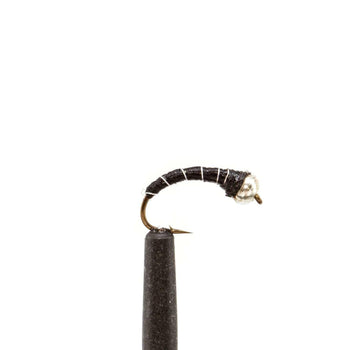 |
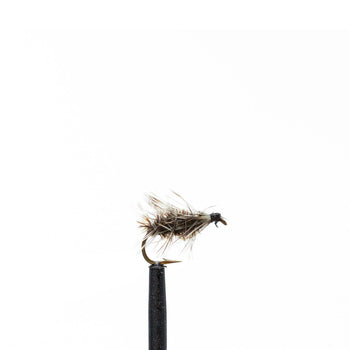 |
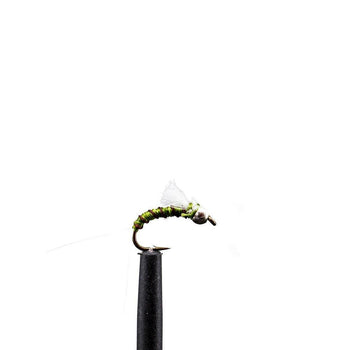 |
 |
|
Zebra Midge Sizes: #18 – #20 |
Griffith's Gnat Sizes: #16 – #22 |
Beadhead RS2 Sizes: #16 – #22 |
WD-40 Sizes: #18 – #24 |
-
Zebra Midge: This fly is a simple but highly effective pattern that mimics a midge pupa. It has a slender body typically made from black thread with a silver wire wrapped around to create segmented sections, topped off with a bead head for extra weight. In spring, fish it deep under an indicator or drop it below a dry fly in areas where trout are feeding on midges near the bottom.
-
Griffith's Gnat: Ideal for imitating a cluster of midges. This fly is small and bushy, made with grizzly hackle and peacock herl. It's great for topwater fishing, especially on calm or slightly breezy days when midges are on the surface. Use a delicate presentation to mimic the natural drift of real insects.
-
Beadhead RS2: A versatile emerger pattern that effectively imitates a variety of small mayflies and midges. It features a sparse gray or olive dubbing body with a wing of white antron yarn and a bead head. This fly is particularly useful during midge and mayfly hatches and can be fished just below the surface film or deeper in the water column.
-
WD-40: This fly mimics a midge or mayfly nymph has a slender body made from thread of various colors (often gray, olive, or brown), a small tuft of feather fibers for the tail, and sometimes a flash wingcase. Fish it with a dead drift in the film or just below, particularly when you notice trout targeting emerging insects.
For midge fishing, especially in clear and cold waters, opting for smaller sizes (18-24) can often be more productive, as these sizes more closely represent the natural insects trout are feeding on. Adjusting the size based on the clarity of the water and the feeding behavior of trout can increase your success rates significantly.
MAYFLIES
Mayflies are a critical part of the trout diet, particularly in spring when these insects are prevalent in many freshwater systems. To effectively match these hatches, having a diverse selection of mayfly patterns is essential. Use a light tippet, like 6x or 7x, for a natural presentation, and observe the water to match the lifecycle stage—nymph, emerger, or adult. Employ a two-fly setup for better visibility and vary your retrieve to mimic natural drift. Focus on slow-moving or still water near rocks and banks, and consider larger sizes or flash for visibility in murky conditions. Adjusting fly size and characteristics based on water clarity and local mayfly species enhances your chances of success.
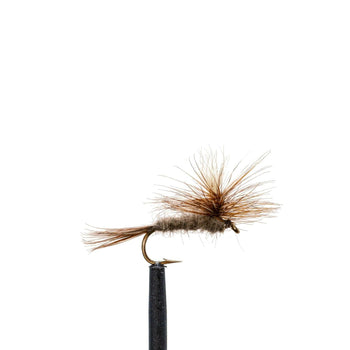 |
 |
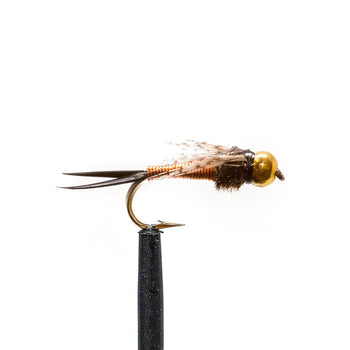 |
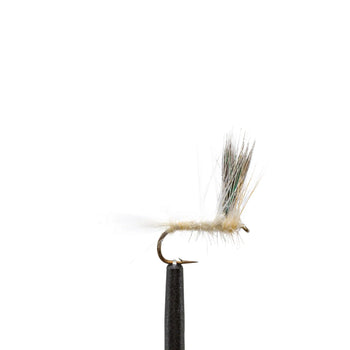 |
|
Adams Parachute Sizes: #12 – #20 |
Blue Wing Olive Parachute Sizes: #16 – #22 |
Copper John Sizes: #14 – #18 |
PMD Parachute Sizes: #16 – #20 |
-
Parachute Adams: Known for its versatility, this fly can imitate a variety of mayfly species. The parachute hackle and tail fibers help it float well, making it a great choice for fishing in riffles and fast water where trout are eagerly feeding on the surface. The post makes it highly visible, and the grey and brown color scheme is very effective.
-
Blue Wing Olive Parachute: An essential pattern during spring BWO hatches. The parachute style ensures it rides low on the water, mimicking a struggling mayfly. Its olive body and dun-colored wings are realistic, making it a go-to choice for selective trout.
-
Copper John: This bead head nymph is effective for deep fishing. It imitates a mayfly nymph and has a flashy, segmented body made of copper wire. It sinks quickly and is great for nymphing in fast currents or deeper pools where trout are feeding on subsurface insects.
-
PMD Parachute: A delicate dry fly that mimics Pale Morning Duns. The parachute post enhances visibility, and the light body color closely matches the natural PMDs. Fish it in slower waters where PMDs are hatching and trout are sipping flies from the surface.
STONEFLIES
Stoneflies are a key food source for trout, particularly in spring when the nymphs are active and the adults begin to hatch. To match stonefly hatches effectively, carry various patterns to mimic different life stages. Use a heavy tippet, like 4x or 5x, to handle the larger flies and aggressive takes. Fish the nymphs deep in fast-moving water and the adults near the surface in slower currents. Focus on riffles and rocky areas where stoneflies are abundant, and vary your retrieve to mimic the natural drift. Adjusting fly size and weight based on water conditions enhances your success.
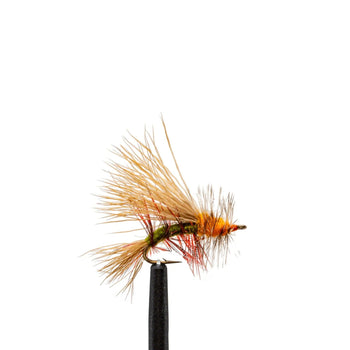 |
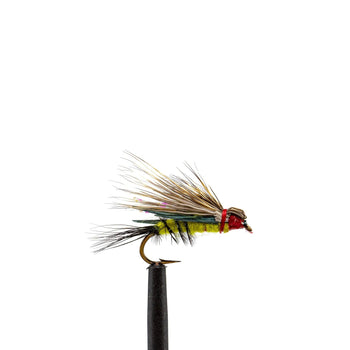 |
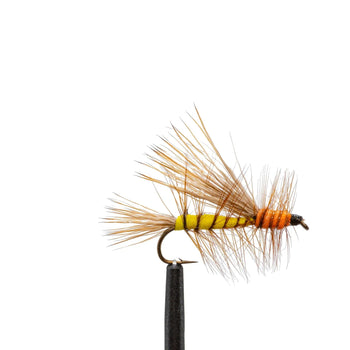 |
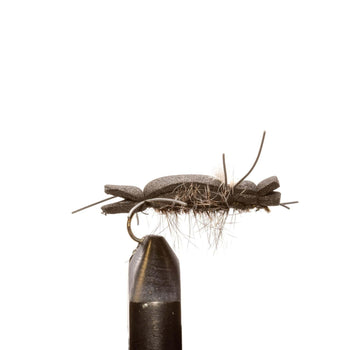 |
|
Olive Stimulator Sizes: #6 – #16 |
Golden Stone Sizes: #8 – #14 |
Yellow Foam Stimulator Sizes: #6 – #16 |
Black Stone Sizes: #10 – #18 |
-
Olive Stimulator: This attractor dry fly works well during yellow and olive stonefly hatches. Its bushy profile and high floatation make it a great choice for fast water. The bright olive body is highly visible, and the hackle provides excellent movement on the water's surface.
-
Golden Stone: A staple for stonefly hatches, this fly imitates the golden stonefly adult. It’s best fished near the banks or in slower water where stoneflies naturally drift after hatching. The gold body and realistic wing color make it very effective.
-
Yellow Foam Stimulator: Another versatile attractor, the yellow foam stimulator is perfect for imitating various stonefly species. The bright yellow body is visible in all water conditions, and its buoyant construction makes it ideal for rough waters. Use it when you need a high-floating, easy-to-see fly.
-
Black Stone: This nymph pattern is designed to mimic black stonefly nymphs, which are abundant in many trout streams. Fish it deep in fast currents where stonefly nymphs are found. The dark body and segmented thorax give it a lifelike appearance that trout can't resist.







